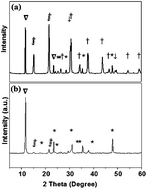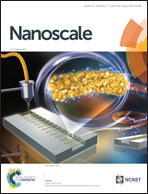Phonon mode transformation in size-evolved solution-processed inorganic lead halide perovskite†
Abstract
Recently, lead halide perovskites have attracted significant scientific attention in the fields of photovoltaics, light emitting diodes, lasers, photo-detectors and other optoelectronic functional devices. The most stable crystal form of lead halide perovskites is the cube, including nano-cube and micro-cube, which hold great promise as functional materials due to their combination of unique optoelectronic properties and versatility through colloidal synthesis. Herein, we report the solution-processed synthesis of pure inorganic lead halide nano-cubes- and micro-cubes-based colloidal perovskites. The different size of cubes either into nano-cube or micro-cube are demonstrated that their phonon mode transformation which means the perovskite crystal structure phase change cross the nano-cube to micro-cube. The solution-processed colloidal synthesis method and phonon-mode transformation from nano-cube to micro-cube make pure inorganic lead halide perovskite an ideal platform for fundamental optoelectronic studies and the investigation of functional devices.



 Please wait while we load your content...
Please wait while we load your content...